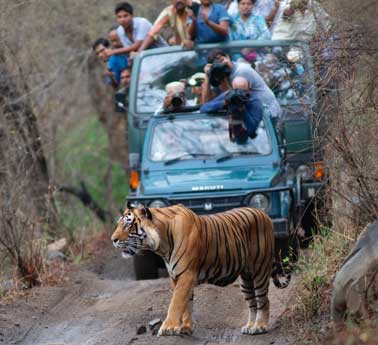Top 5 National Parks in Rajasthan
Rajasthan, often celebrated for its vibrant culture, majestic forts, and sprawling deserts, is also home to some of India's most remarkable national parks. These parks, scattered across the state, are sanctuaries for a diverse array of wildlife and offer visitors a chance to immerse themselves in the natural beauty of Rajasthan. Here are the top five national parks in Rajasthan, each with its unique charm and ecosystem.
Ranthambore National Park
Covering an area of over 1,300 square kilometers, Ranthambore National Park is one of the largest and most renowned national parks in India. Located in the Sawai Madhopur district of southeastern Rajasthan, Ranthambore is perhaps best known for its population of Bengal tigers. The park's rugged terrain, dotted with ancient ruins and picturesque lakes, provides a dramatic backdrop for wildlife sightings. Besides tigers, visitors to Ranthambore may also encounter leopards, sloth bears, wild boars, and a variety of bird species. Jeep safaris and guided tours offer opportunities for wildlife enthusiasts to explore the park and observe its inhabitants in their natural habitat.


Sariska Tiger Reserve
Nestled in the Aravalli Range of Alwar district,Sariska Tiger Reserve is another prominent wildlife destination in Rajasthan. Initially established as a hunting reserve by the Maharajas of Alwar, Sariska was later declared a wildlife sanctuary in 1955 and eventually designated as a tiger reserve in 1978. While Sariska is known for its tiger population, the sanctuary also shelters species such as leopards, wild dogs, hyenas, and numerous bird species. The landscape of Sariska is diverse, encompassing scrublands, dry deciduous forests, and rocky hills, offering a rich tapestry for wildlife exploration.
Keoladeo National Park (formerly Bharatpur Bird Sanctuary)
Recognized as a UNESCO World Heritage Site, Keoladeo National Park is a paradise for bird lovers. Located in the Bharatpur district of Rajasthan, this wetland ecosystem is a crucial wintering ground for migratory birds, attracting thousands of avian species from as far as Siberia and Central Asia. The park's shallow lakes, marshes, and dense vegetation provide an ideal habitat for birds such as cranes, storks, pelicans, and ducks. Apart from birdwatching, visitors can also explore the park on cycle rickshaws or boats, immersing themselves in the tranquil ambiance of nature.
Desert National Park
As the name suggests, Desert National Park showcases the unique ecosystem of the Thar Desert, the largest desert in India. Situated near the town of Jaisalmer, this park spans an area of over 3,000 square kilometers and is characterized by rolling sand dunes, rocky outcrops, and sparse vegetation. Despite the harsh conditions, Desert National Park is home to a surprising variety of wildlife, including desert foxes, chinkaras, blackbucks, and the critically endangered great Indian bustard. Visitors can embark on desert safaris, camel rides, or guided treks to experience the enchanting beauty of the desert landscape.
Mount Abu Wildlife Sanctuary
Unlike the other parks on this list, Mount Abu Wildlife Sanctuary offers a refreshing contrast with its lush greenery and cool climate. Located in the Aravalli Range near the hill station of Mount Abu, this sanctuary provides a sanctuary for a diverse range of flora and fauna. The sanctuary is home to species such as sloth bears, leopards, Indian pangolins, and various bird species. Visitors can explore the sanctuary's winding trails, serene lakes, and dense forests, enjoying moments of tranquility amidst nature's bounty.
Jhalana Leopard Reserve
Jhalana Leopard Reserve, situated on the outskirts of Jaipur, is a remarkable sanctuary dedicated to the conservation of leopards in their natural habitat. Spanning over 20 square kilometers, this reserve offers a rare opportunity to observe leopards in the wild against the backdrop of the city skyline. Visitors can embark on guided safaris through the rocky terrain, enhancing their chances of spotting these elusive big cats while also enjoying sightings of other wildlife species and birdlife.
In conclusion, Rajasthan's national parks offer a captivating blend of wildlife, landscapes, and cultural heritage. Whether you're seeking the thrill of spotting a majestic tiger, the tranquility of birdwatching amidst wetlands, or the rugged beauty of the desert, Rajasthan's national parks have something to offer for every nature enthusiast. These sanctuaries stand as testament to the state's commitment to conservation and provide invaluable opportunities for wildlife conservation and eco-tourism.

